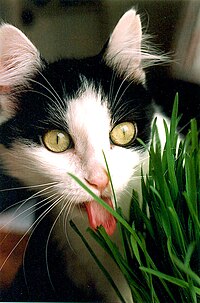
Photo from wikipedia
The present study attempted to evaluate and rationalize the medicinal use of the methanolic extract of the fruits of Balanites aegyptiaca (B. aegyptiaca) in the treatment of hyperactive gut disorders.… Click to show full abstract
The present study attempted to evaluate and rationalize the medicinal use of the methanolic extract of the fruits of Balanites aegyptiaca (B. aegyptiaca) in the treatment of hyperactive gut disorders. The in vivo, castor oil-induced diarrhea model in mice was followed to test its antidiarrheal effect. To test the antispasmodic effect and to explore its pharmacodynamic details, isolated small intestines (ileum) obtained from rats were selected to provide physiological conditions for the ex vivo assays. In the in vivo assays, the orally administered extract of B. aegyptiaca protected mice from diarrheal drops with resultant percent inhibitions of 40% and 80% at the respective doses of 200 mg/kg and 400 mg/kg, while the highest protection (100%) was observed with a positive control drug, loperamide, at 10 mg/kg. In the ileum, B. aegyptiaca produced an antispasmodic effect in a concentration-dependent manner by inhibiting the carbachol (CCh; 1 µM) and high K+ (80 mM)-evoked spasms with resultant EC50 values of 1.44 mg/mL (1.08–1.78) and 1.27 mg/mL (0.98–1.66), respectively. Papaverine, a known phosphodiesterase enzyme (PDE) inhibitor and blocker of Ca++ channels (CCB), also inhibited both CCh and high K+ induced contractions at comparable EC50 values of 8.72 µM (7.92–9.24) and 8.14 µM (7.62–8.84), respectively. Contrary to the extract and papaverine, verapamil showed distinctly higher potency in regard to inhibiting high K+, compared to CCh-evoked spasms that had EC50 values of 0.16 µM (0.13–0.261) and 2.54 µM (2.28–2.92), respectively. The inhibitory effects of B. aegyptiaca on PDE were further confirmed when the pre-incubated extract shifted the isoprenaline-mediated relaxation curves (CRCs) towards the left, similar to papaverine, whereas the CCB-like effect was confirmed when the pre-incubated tissues with B. aegyptiaca caused deflection in the Ca++ CRCs towards the right, constructed in Ca++ free medium with suppression of the maximum response. Thus, this study provides detailed, mechanistic support for the medicinal use of B. aegyptiaca in the treatment of hyperactive gut disorders.
Journal Title: Plants
Year Published: 2022
Link to full text (if available)
Share on Social Media: Sign Up to like & get
recommendations!